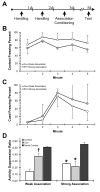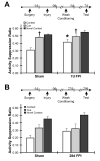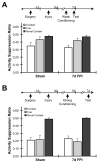Acute cognitive impairment after lateral fluid percussion brain injury recovers by 1 month: evaluation by conditioned fear response
- PMID: 17169443
- PMCID: PMC1851906
- DOI: 10.1016/j.bbr.2006.11.014
Acute cognitive impairment after lateral fluid percussion brain injury recovers by 1 month: evaluation by conditioned fear response
Abstract
Conditioned fear associates a contextual environment and cue stimulus to a foot shock in a single training trial, where fear expressed to the trained context or cue indicates cognitive performance. Lesion, aspiration or inactivation of the hippocampus and amygdala impair conditioned fear to the trained context and cue, respectively. Moreover, only bilateral experimental manipulations, in contrast to unilateral, abolish cognitive performance. In a model of unilateral brain injury, we sought to test whether a single lateral fluid percussion brain injury impairs cognitive performance in conditioned fear. Brain-injured mice were evaluated for anterograde cognitive deficits, with the hypothesis that acute injury-induced impairments improve over time. Male C57BL/6J mice were brain-injured, trained at 5 or 27 days post-injury, and tested 48h later for recall of the association between the conditioned stimuli (trained context or cue) and the unconditioned stimulus (foot shock) by quantifying fear-associated freezing behavior. A significant anterograde hippocampal-dependent cognitive deficit was observed at 7 days in brain-injured compared to sham. Cued fear conditioning could not detect amygdala-dependent cognitive deficits after injury and stereological estimation of amygdala neuron number corroborated this finding. The absence of injury-related freezing in a novel context substantiated injury-induced hippocampal-dependent cognitive dysfunction, rather than generalized fear. Variations in the training and testing paradigms demonstrated a cognitive deficit in consolidation, rather than acquisition or recall. By 1-month post-injury, cognitive function recovered in brain-injured mice. Hence, the acute injury-induced cognitive impairment may persist while transient pathophysiological sequelae are underway, and improve as global dysfunction subsides.
Figures




References
-
- Abel T, Lattal KM. Molecular mechanisms of memory acquisition, consolidation and retrieval. Curr Opin Neurobiol. 2001;11:180–187. - PubMed
-
- Abrous DN, Rodriguez J, Le Moal M, Moser PC, Barneoud P. Effects of mild traumatic brain injury on immunoreactivity for the inducible transcription factors c-Fos, c-Jun, JunB, and Krox-24 in cerebral regions associated with conditioned fear responding. Brain Res. 1999;826:181–192. - PubMed
-
- Adams JH, Doyle D, Ford I, Gennarelli TA, Graham DI, McLellan DR. Diffuse axonal injury in head injury: definition, diagnosis and grading. Histopathology. 1989;15:49–59. - PubMed
-
- Adolphs R, Gosselin F, Buchanan TW, Tranel D, Schyns P, Damasio AR. A mechanism for impaired fear recognition after amygdala damage. Nature. 2005;433:68–72. - PubMed
-
- Albensi BC, Sullivan PG, Thompson MB, Scheff SW, Mattson MP. Cyclosporin ameliorates traumatic brain-injury-induced alterations of hippocampal synaptic plasticity. Exp Neurol. 2000;162:385–389. - PubMed
Publication types
MeSH terms
Grants and funding
LinkOut - more resources
Full Text Sources

